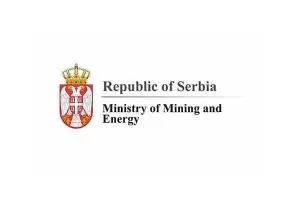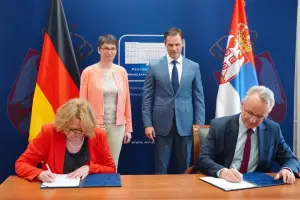- Serbia
Get to know Serbia
- Citizens
Culture and science
Health services
Pension and disability insurance
- Business
Employment
Economy
- Media
- Government
- Contact
Keep in touch
Contact form
Back
Keepin touch
Whether you have a question, comment, suggestion or any problem in the purview of the government, send us your message and we will try to respond as soon as possible. If your problem is not in our purview, we will forward your message to the relevant institution.
Q:
A:
5.8% growth in total economic activity this year
Belgrade,
28 December 2006
The Serbian Statistical Office has stated today that growth in total economic activity this year, measured through gross domestic product (GDP) and reflected in permanent prices in 2002, was up 5.8% against the previous year, without including data from Kosovo-Metohija.
According to the statement, by sectors, the biggest growth rate was seen in the sectors of transport, financial mediation and building, while in all other sectors the rate of growth was significantly smaller, except in the sectors of tourism, state and health.
Industrial production, after a mild rise of 0.8% in 2005, saw a growth of 4.4% in 2006, largely due to a growth rate of 5% in the processing industry. Agricultural production rose 0.9% in 2006.
Building in this year saw a record growth of 11.8%.
There was a growth of 6.5% in retail trade, and a faster growth of 7.5% was recorded in wholesale trade.
The hospitality industry saw a fall of 8.4% in 2006, continuing the downward trend from previous years.
The upward trend in the transport sector continued with a rise of 11.4%, telecommunications saw a rise of 38.7%, and there was a rise of 7.9% in postal activities.
The employment rate fell by 1.3% this year, this rate being higher for women.
Salaries without taxes and contributions continued to grow this year, and were up 24.1% in nominal terms and 11.2% in real terms, against 2005.
Average retail price growth in 2006 is 12.7%, in which retail prices for industrial products increased by 12.2%; while for agricultural products they increased by 17.7%.
Cost of living increased by 11.6%, the average annual growth in producer prices of industrial products was 13.3%, while this rate for producer prices in agriculture and fishery was 9.1%.
All data on economic activity in 2006 were established on the basis of available and until now processed statistics, and do not include data from Kosovo-Metohija.
The most important macro-economic aggregate, the GDP, is the measure of total economic activity in all official institutional units.
The GDP data shown is internationally relevant, and include the production of goods and all types of services, those connected to goods production, those in the state sector, the sectors of health, education, financial mediation and others, reads the statement.
Industrial production, after a mild rise of 0.8% in 2005, saw a growth of 4.4% in 2006, largely due to a growth rate of 5% in the processing industry. Agricultural production rose 0.9% in 2006.
Building in this year saw a record growth of 11.8%.
There was a growth of 6.5% in retail trade, and a faster growth of 7.5% was recorded in wholesale trade.
The hospitality industry saw a fall of 8.4% in 2006, continuing the downward trend from previous years.
The upward trend in the transport sector continued with a rise of 11.4%, telecommunications saw a rise of 38.7%, and there was a rise of 7.9% in postal activities.
The employment rate fell by 1.3% this year, this rate being higher for women.
Salaries without taxes and contributions continued to grow this year, and were up 24.1% in nominal terms and 11.2% in real terms, against 2005.
Average retail price growth in 2006 is 12.7%, in which retail prices for industrial products increased by 12.2%; while for agricultural products they increased by 17.7%.
Cost of living increased by 11.6%, the average annual growth in producer prices of industrial products was 13.3%, while this rate for producer prices in agriculture and fishery was 9.1%.
All data on economic activity in 2006 were established on the basis of available and until now processed statistics, and do not include data from Kosovo-Metohija.
The most important macro-economic aggregate, the GDP, is the measure of total economic activity in all official institutional units.
The GDP data shown is internationally relevant, and include the production of goods and all types of services, those connected to goods production, those in the state sector, the sectors of health, education, financial mediation and others, reads the statement.
-
 Belgrade, 21 July 2025
Belgrade, 21 July 2025Construction of oil pipeline with Hungary to begin early next year
-
 Belgrade/Athens, 17 July 2025
Belgrade/Athens, 17 July 2025Serbia continues to align with EU in field of energy
-
 Kostolac, 14 July 2025
Kostolac, 14 July 2025First solar power plant Petka in Kostolac put into trial operation
-
 Belgrade, 11 July 2025
Belgrade, 11 July 2025Potential for improving cooperation with Belarus in many areas
-
 Požega, 5 July 2025
Požega, 5 July 2025Section of Pakovraće - Požega highway officially opened
-
 Belgrade, 2 July 2025
Belgrade, 2 July 2025Technical specifications defined for Serbia-Hungary oil pipeline
-
 Belgrade, 30 June 2025
Belgrade, 30 June 2025IMF confirms Serbia successfully implementing all agreed reforms
-
 Belgrade, 27 June 2025
Belgrade, 27 June 2025Double Taxation Avoidance Agreement with Germany signed
-
 Kostolac, 25 June 2025
Kostolac, 25 June 2025Construction of Kostolac wind farm nearing completion
-
 Belgrade, 24 June 2025
Belgrade, 24 June 2025Government supports request for new postponement of sanctions against NIS
